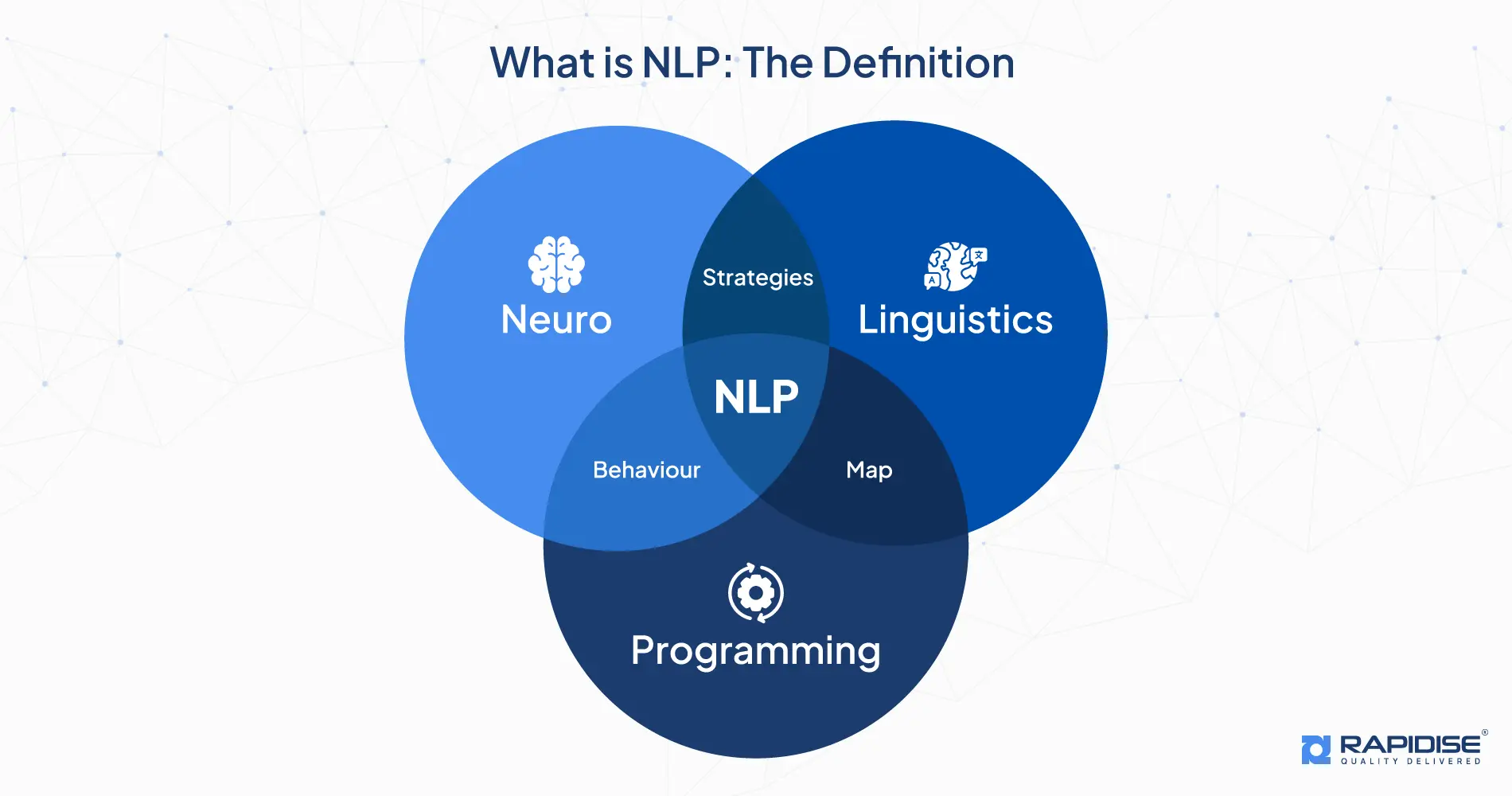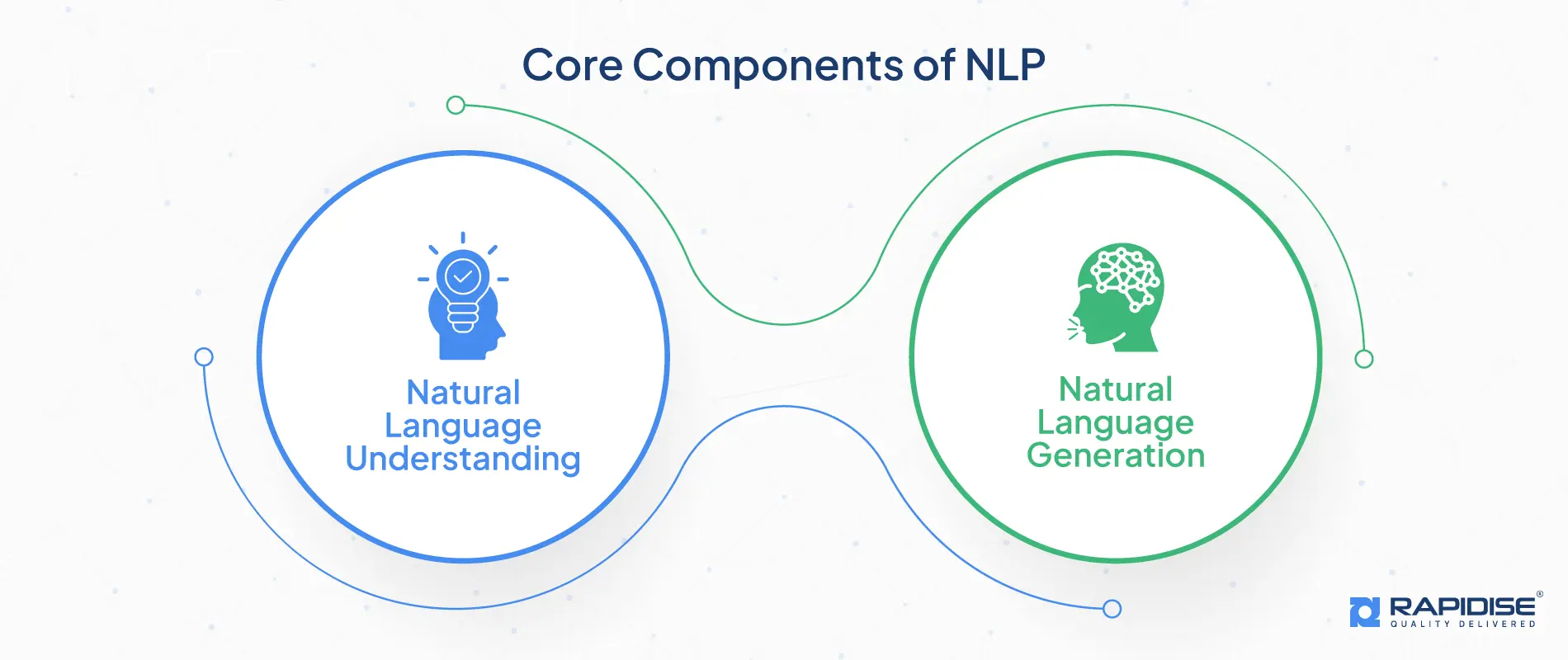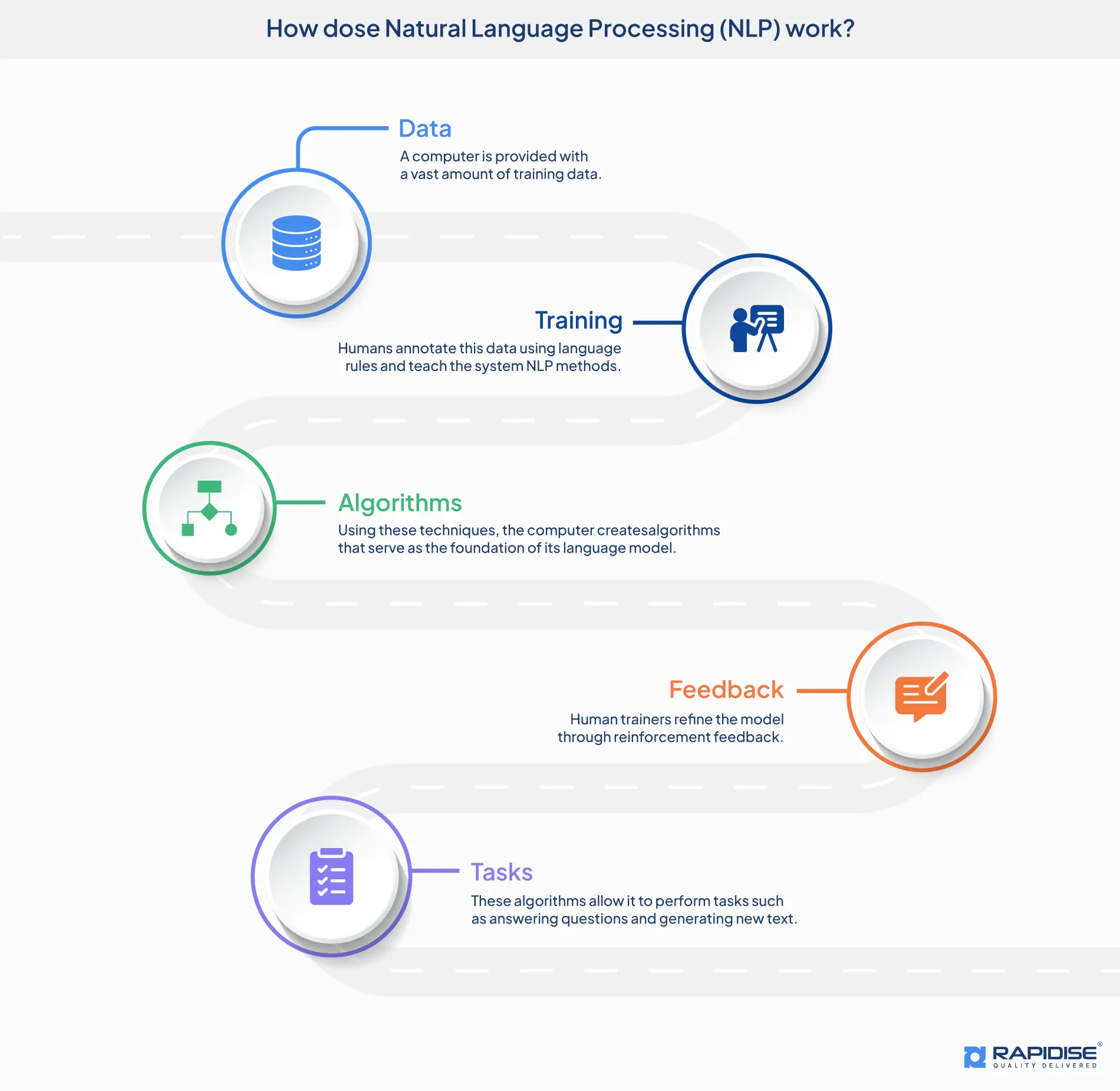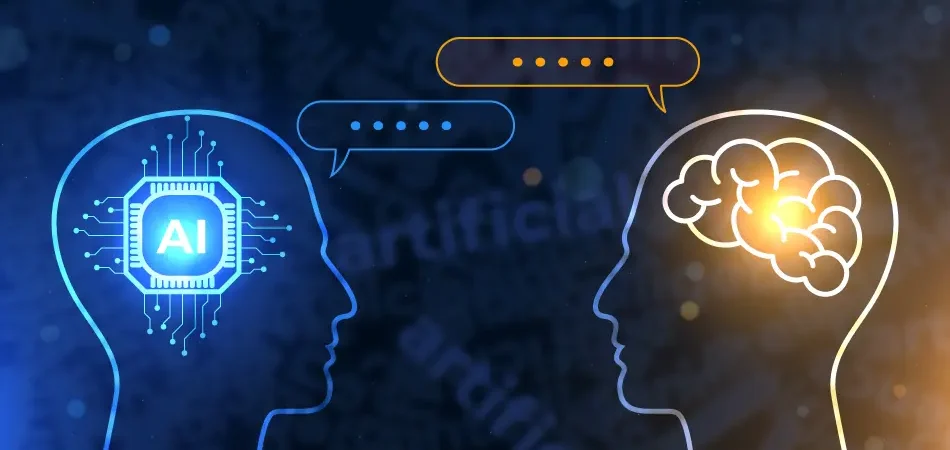Introduction
This blog will explain NLP extensively by discussing its definition along with the components and benefits along with techniques and applications and challenges with future trends.
What is NLP: The Definition

Computers powered by Natural Language Processing (NLP) branch of artificial intelligence (AI) receive the ability to understand human speech and generate text outputs like human beings do. The system carries out computational linguistics coupled with deep learning and machine learning capabilities to handle vast amounts of natural language information for human-computer communication operations.
Core Components of NLP

1. Natural Language Understanding (NLU)
The main objective of Natural Language Understanding (NLU) involves giving machines capabilities to understand language interfaces meaningfully. Multiple sub-processes enable AI to correctly understand and analyze text contents during natural language processing.
- The analysis platform determines sentiment by evaluating text emotions before classifying them as positive negative or neutral.
- Users can achieve better outcomes through intent recognition systems that determine their specific goals in any query thus making them indispensable components for chatbots alongside voice assistants.
- NER (Named Entity Recognition) systems extract particular data along with performing classifications of names and dates and locations and company names.
- Syntax and semantics analysis which include examine the grammatical structure of sentences and the meanings of words in context.
AI-enabled systems that employ NLU can process user requests and extract the intended purpose while generating precise answers thus enabling automation across customer support and healthcare and financial services and additional industry sectors.
2. Natural Language Generation (NLG)
NLG operates as a system which transforms numerical information into texts that mimic human writing style. AI utilizes this approach to create meaningful responses and generate reports as well as summaries.
- AI tools harness data templates to develop content items that include articles and marketing materials with reports.
- Floated summaries through automated summarization process text materials by extracting key things from massive documents.
- The combination of Chatbots and Virtual Assistants through AI technology results in production of context-sensitive coherent replies.
- The system produces adapted content suggestions which use individual user experiences along with their past selections to make recommendations.
The technology enables industrial automation of textual content generation coupled with user interface personalization and triggers easy access to intricate datasets.
Run Your Business Through AI/ML
Leverage cutting-edge AI and machine learning to automate processes, gain insights, and enhance decision-making.
Benefits of NLP
Automation of Repetitive Tasks
The automation features of NLP minimize manual work at the same time they boost operational speed. The use of NLP-driven solutions permits businesses to automate both their customer service operations and their meeting transcription functions and their document management procedures. The automated system allows organizations to direct their resources toward strategic initiatives while they remove their staff from their daily routine tasks.
Improved Data Analysis and Insights
Making up a considerable portion of unstructured data exist within business-generated texts from sources including emails reviews and social media content. Through NLP technology businesses evaluate vast data streams effectively to uncover strategic deliverables which leads to well-informed decisions. Organizations gain superior operational performance and better marketing methods through identifying key market trends while also improving the quality of customer support.
Enhanced Search
Undertaking user search queries more effectively enables search engines alongside enterprise search systems to provide users with better results through the application of NLP. The search engines with NLP technology analyze contextual information together with synonyms and user intent to provide users with their most suitable results. NLP technology enhances business application and research database and customer support portal search capability by performing better information retrieval processes.
Content Generation
AI-powered NLP tools enable organizations to create superior content materials within different professional fields. NLP applications aid businesses in developing product content along with producing reports while summarizing documents and creating news content. These tools maintain uniform content generation by reducing the time needed as well as maintaining continuous delivery of high-quality material.
Approaches to NLP
Rules-based NLP
This includes spell check functions and keyword retrieval steps as well as data organization processes. The system faces difficulties dealing with ambiguous terms and informal language together with shifting textual patterns which reduces its capacity to handle complex real-life duties.
Statistical NLP
The text analysis methods used regularly by machine learning systems consist of Hidden Markov Models (HMMs) and Conditional Random Fields (CRFs). Statistical NLP achieves higher accuracy in language processing yet needs both vast labeled data quantity and powerful computing resources.
Deep learning NLP
Widespread implementation of deep learning NLP techniques applies to machines that imitate human conversations and translation systems and emotion detection systems as well as automated writing software. The system proves to be cutting-edge but its extensive training needs huge databases alongside powerful computing facilities.
Transform Your Customer Experience with NLP-Powered AI
Increase engagement with intelligent chatbots, sentiment analysis, and personalized recommendations.
Key NLP Techniques and Concepts
- Coreference Resolution: This system links all expressions referring to identical entities throughout the text. John proceeded to visit the store. The model recognizes that the pronoun “He” represents John according to the sentence “He bought milk.”
- Named Entity Recognition: The technology assigns labels to proper names and locations as well as organizations and other entities present in text to help extract structured data.
- Part-of-speech Tagging (POS Tagging): Grammatical classification enables word assignment as nouns or verbs or adjectives thus providing structure analysis for sentences.
- Word Sense Disambiguation: The system selects the accurate word definition from surrounding text. The intended meaning of a word such as “bat” gets determined between animal and sports equipment by NLP systems.
- Tokenization: Text segmentation tool divides content into three parts which include sentences, phrases and words. The processing stands as a vital initial step before many NLP applications can commence.
- Stemming and Lemmatization: This operation converts word words back to their most basic essential forms. Stemming removes word prefixes to get basics (running becomes run) yet lemmatization performs base word identification across context and grammar rules (better changes to good).
- Parsing: The style of analysis examines grammatical structures to discover word relationships which becomes essential for translating devices as well as sentiment detection systems.
- Word Embeddings (Word2Vec, GloVe): A system transforms words into vector numbers which preserve semantic meaning together with relational patterns to make devices interpret context effectively.
- Recurrent Neural Networks (RNNs) and Transformers: Advanced deep learning techniques operate on NLP applications which include machine translation along with text generation procedures. Transformers especially BERT and GPT along with other variants have boosted NLP accuracy by discovering extensive textual associations.
How NLP Works?

NLP uses text transformation as its first step to process human language before conducting analysis and performing model training. These procedures make it possible for machines to decode texts automatically for proper interpretation along with response generation.
Text preprocessing
NLP functionality starts from text preprocessing operations. Text preprocessing consists of two main operations which transform unorganized raw data into a structure appropriate for machine learning model use. This step includes:
- Tokenization: A text transformation method splits long documents into shorter sequential units which can be words or sentences.
- Stop Word Removal: The removal of stop words which includes “the,” “is,” and “in” allows noise reduction in the data.
- Lowercasing: Converting all text to lowercase for consistency.
- Punctuation Removal: A stage of processing involves deleting all discrete punctuation elements from the text.
- Stemming & Lemmatization: The base forms of words obtained through Stemming and Lemmatization methods normalize various word expressions.
Feature extraction
The text needs to undergo numerical conversion to make it compatible for machine learning algorithm processing. Feature extraction methods include:
- Bag of Words (BoW): Represents text as word frequency counts.
- Term Frequency-Inverse Document Frequency (TF-IDF): Measures word importance in a document relative to a dataset.
- Word Embeddings (Word2Vec, GloVe, BERT): Word Embeddings technologies transform textual words into adjustable vector forms that track semantic content and contextual examples.
Text analysis
In the third stage the implementation of NLP algorithms interprets and retrieves meaningful information from textual content. Some key tasks include:
- Named Entity Recognition (NER): The NER system detects the names of all entities including both persons along with locations and organizational entities.
- Sentiment Analysis: Determines the emotional tone behind a text (positive, negative, neutral).
- Part-of-Speech Tagging (POS): Assigns grammatical roles like noun, verb, or adjective to words.
- Dependency Parsing: Analyzes sentence structure and relationships between words.
Model training
High-level NLP applications use machine learning models which process extensive datasets to spot patterns during training for creating intelligent forecasting functions. Model training typically involves:
- Supervised Learning: Text classification models learn through supervised learning techniques using previously identified data examples (for example in spam detection operations).
- Unsupervised Learning: The approach of Unsupervised Learning allows analysts to find patterns without label information in their data sets, for example through topic modeling.
- Deep Learning Models: Leveraging neural networks such as Recurrent Neural Networks (RNNs) and Transformers for more sophisticated language processing.
Computational linguistics
The combination of computational approaches in linguistics with computer science produces refined language models. The approval of NLP accuracy depends on researchers understanding and refining the components including syntax along with semantics as well as phonetics and language structures.
- Machine Learning: Uses decision trees and Native Bayes together with support vector machines (SVMs) algorithms.
- Deep Learning: The neural networks LSTM together with Transformers which include BERT and GPT efficiently perform complex NLP operations such as machine translation and text generation.
Applications of NLP
Natural Language Processing (NLP) functions in multiple fields through which organizations automate operations to boost efficiency and strengthen human-machine dialogue.
Chatbots and Virtual Assistants
NLP powers AI-driven chatbots and virtual assistants like Siri, Alexa, and Google Assistant. Users can interact with these systems through their queries and requests while the systems provide meaningful outcomes to improve support functions and personal assistance methods. Fairfield – Cruise Lines adopts chatbots for their online operations to address customer queries and schedule reservations and manage customer support questions.
Machine Translation
NLP technology enables Google Translate along with similar tools to perform text translation between different languages. The advanced versions of NLP models analyze sentence structure together with contextual information and linguistic expressions to improve translation accuracy. The transformational NMT techniques along with Transformer-based models have produced substantial improvements to translation output quality.
Sentiment Analysis
Through NLP businesses obtain the ability to extract customer sentiment information from online reviews and social media comments together with feedback forms. Companies achieve better product development and boost their brand profile by using detection systems to analyze positive and negative emotional expressions. The analysis technique of sentiment exists commonly within marketing operations and affects customer experience management.
Spam Detection
Email services apply NLP techniques for detecting and blocking spam and phishing messages through their platforms. The algorithms which detect spam conduct email content assessments to find spam keywords and harmful links as well as suspicious patterns. The accuracy of machine learning models increases through time by processing user identification of spam emails.
Search Engines
The search technology of Google and Bing depends on NLP to recognize user needs which enables them to deliver appropriate search results. Search results receive increased accuracy because NLP enables three techniques which include keyword extraction as well as semantic search and query expansion. The ability to process voice search depends entirely on NLP interpretation.
Content Recommendation
Through NLP technology streaming websites together with e-commerce and news platforms deliver customized content suggestions to their users. Through evaluation of user conduct patterns and historical movement along with personal choices NLP systems generate suitable recommendations for movies or products or articles. The system enhances user interaction which leads to better customer satisfaction.
Challenges of NLP
The accomplishments of NLP face multiple obstacles which decrease both its performance reliability and operational speed. Technical obstacles in NLP occur because of complex linguistic elements along with textual context shifts and quick changes in language usage.
Biased training
Large dataset training for NLP models leads to potential bias that arises from gender-specific and ethnic-based as well as cultural influences. The way biases have been curated determines how model outputs appear and whether the outcomes create unfair or discriminatory results. The elimination of bias demands collection from various sources and algorithmic fairness tools as well as systematic monitoring systems for AI systems.
Misinterpretation
Machines face challenges when dealing with both sarcasms together with humor and idioms and culturally specific moments. For instance, the phrase “Great job!” represented by this statement carries true meaning in positive situations whereas it could suggest mockery when the context demands such interpretation. The current NLP systems do not possess sufficient contextual insight that leads to uncertain meanings in specific situations. Transformers together with contextual embeddings serve as advanced deep learning techniques that work towards reducing such weaknesses.
New vocabulary
The way language operates undergoes permanent change because new expressions alongside slang terms add themselves frequently to the world’s linguistic system. The NLP models need to perform regular updates to process new language patterns that emerge in the market. Social media memes together with specialized industry terms make processing difficult for language models which need continuous updates as well as immediate capacity for adaptation.
Tone of voice
Wrong interpretation of tone during sentiment analysis creates both inaccurate analysis results and poor insights about customers. AI models with emotion detectability together with multimodal NLP systems using voice and facial expression analysis are developed to solve this matter.
NLP Use Cases by Industry
Natural Language Processing technology revolutionizes different industries by allowing automation systems and boosting operational efficiency along with decision quality enhancement. Different industries employ NLP models for specialized purposes which span from security surveillance to financial market evaluation.
Security & Surveillance
Large dataset training for NLP models leads to potential bias that arises from gender-specific and ethnic-based as well as cultural influences. The way biases have been curated determines how model outputs appear and whether the outcomes create unfair or discriminatory results. The elimination of bias demands collection from various sources and algorithmic fairness tools as well as systematic monitoring systems for AI systems.
Healthcare
Healthcare chatbots operate through NLP technology to perform first evaluations and answer questions which lightens the workloads of medical staff. The conversion of spoken language into accurate structured medical records becomes more efficient through the implementation of NLP for medical transcription services.
Insurance
The use of sentiment analysis by insurers enables them to conduct customer feedback assessments which improves their service delivery. Through NLP programming the solution identifies inconsistencies within insurance claim documents which lowers the occurrence of fraudulent settlements and establishes fair payment systems.
Finance
Through NLP-driven chatbots customers can manage their accounts and conduct transactions and ask questions to get their queries answered quickly. The detection of fraud receives support from NLP because the technology recognizes abnormal financial statement patterns alongside irregular transaction documentation.
Legal
The efficiency of legal research becomes better through NLP because it allows users to find applicable case laws rapidly. Law professionals use predictive analytics with NLP technology to evaluate past legal decisions for making effective case outcome predictions.
Build Scalable AI/ML Solutions for Your Industry
From healthcare to finance, our AI/ML experts develop tailored solutions to meet your unique business needs.
The Future of NLP
Natural Language Processing (NLP) stands at the edge of advanced development because of technological evolution which will unlock new business possibilities in various industries. The following developments forecast how NLP will evolve:
Improved Understanding
NLP models continuously advance to improve their capability for understanding textual context combined with speaking attributes and underlying meanings. Complex deep learning transformer models including GPT and BERT and T5 operate persistently for enhancing accuracy in NLP systems. The upcoming development of NLP technology centers on lowering misunderstandings while improving machine capabilities to process subtle language and sarcastic content and unclear verbalizations.
Multilingual NLP
The upcoming era will provide better infrastructure for NLP models to handle less prominent spoken languages. The language barrier is beginning to fall due to the development of multilingual models particularly mBERT and XLM-R. Modern models developing abilities will lead to instant translation while increasing cross-language understanding capabilities for English non-speakers and enhancing accessibility features.
Personalized Experiences
AI-powered NLP technology uses user data to deliver customized conversations together with suggestion features and targeted content output. The development of NLP systems toward future use will lead to natural interactions with context awareness in e-commerce platforms and healthcare services and customer support roles.
Ethical Considerations
The increasing prevalence of NLP demands immediate action to resolve moral issues linked to bias, wrong information distribution and privacy violations. AI systems automatically acquire prejudices from their training sources which creates problems regarding fairness. Future NLP systems will adopt three main approaches to reduce bias through enhanced datasets as well as ethical AI frameworks and explainable AI (XAI) methods to attain decision-making transparency.
Integration with Other AI Fields
NLP will develop new possibilities for progress when collaborating with computer vision and reinforcement learning and robotics technology. Multimodal AI technology unites three processing methods through text, images and voice to develop modern virtual assistants as well as intelligent search engines with interactive AI systems. Records and contextual understanding will improve in applications when NLP joins forces with artificial intelligence that uses reasoning and knowledge graph systems.
Conclusion
Machines are transforming their human interaction capabilities through NLP technology to establish smarter and more intuitive communication. The improvements of AI technology with deep learning systems will shape NLP into an enabler of business innovation across different sectors. Organizations that use NLP technology boost their operational speed alongside superior customer interactivity and data analysis decisions.
